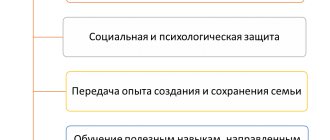MAGAZINE Preschooler.RF
Psychological training for parentsWinner of the all-Russian competition “The most popular article of the month” October 2017
Conditions of the competition:
Lesson No. 1 “GET TO KNOW” Goal: to help parents get to know each other, to get to know each other better for successful interaction in the future. Preparation: parents bring one family photo (if dad and mom, then 2 photos). PROCEDURE Those present take their places, forming one large circle. The teacher-psychologist informs the purpose of the training and invites parents to be frank, open, and sincere. The first task is “Getting to know each other.” Each of the parents calls himself as he would like to be addressed today, and writes down his name or first and patronymic on a sheet prepared in advance by the teacher or purchased (the so-called badge) and attaches it to your clothes.
Second task - “Our children” Invite parents, who are called in any order, to remember several qualities of their child, the names of which begin with the same letter as the child’s name (for example, Seryozha - modest, independent; Misha - silent, dreamer etc.). Third task - “Warm-up” 1. Those parents who: • own a musical instrument come out into a circle and shake hands with each other; • go in for sports; • doing handicrafts, etc. 2. The teacher removes one chair and places it in the middle of the circle. At his signal, some parents must move to other places, and one of them does not have time to take a chair (since there are 1 fewer chairs than the number of participants), he stands in a circle and offers his task. Task options: • those who have a son (daughter) are transplanted; • who has more than two children; • who has a musical (technical, medical, pedagogical) education; • who likes to travel around their native land; • who is interested in the history of their native land; • who is an expert in Russian literature, etc. Fourth task - “Choose a pair” The teacher offers to choose a pair. It is advisable to invite the person you know least to be your partner. In one minute you need to tell as much as possible about yourself. Then switch roles. The teacher records the time. After this, the teacher invites some parents to tell everyone about the most interesting thing that they learned from the interlocutor. (A story about yourself at the beginning of the task can be replaced with a system of questions that must be asked within one minute in order to learn as much as possible about the interlocutor within a minute.) Fifth task - “Split into groups” To unite into groups, first the parents stand in a row and sequentially called: red, yellow, green, blue. Each group (“red”, “yellow”, “green”, “blue”) sits separately. Each parent tells all group members about his family photo (where? who? when?). Then they find out what all these photographs have in common. (Time of year, time, place, etc.) Come up with a group name and motto. And at the very end the groups are introduced. Sixth task - “Results” Everyone returns to the big circle. The teacher passes a skein of thread in a circle and asks to share their impressions: what their mood is, what they liked, what they learned useful for themselves, wishes, etc. The teacher’s final word is dedicated because it unites everyone present - it is a symbolic thread in raising children.
LESSON No. 2 “Values in raising a child”
Goal: to determine the true values in your life and help realize your capabilities in raising a child. 1.Greeting 2.Exercise “Trash can” On pieces of paper, write down all those qualities that interfere with effective communication with loved ones, and which you would like to get rid of. After you have written down these qualities, think about what you would like to receive in return? Write down the desired qualities on paper. Throw the pieces of paper with unnecessary qualities into the trash, and keep those with the desired qualities. 3. Exercise “Value Scale” Parents are asked to mark the values they have on a horizontal straight line, symbolizing the scale of life values. Then, using a 10-point system, estimate the amount of time they invest in each area: work, everyday life, store, television, children, friends, dacha. The discussion of this exercise is built around the following questions: “How much time do we devote to children? What emotional state are we in when interacting? What feelings does the child experience when communicating with us? What results do we expect from this approach to raising children? 4. Exercise “Future” Parents are asked to answer the question: “What do you want your child to be like in adulthood?” Write your answers in column No. 1. then fill out columns No. 2 and No. 3.
The answer to the question: “What do you want your child to be like in adulthood?” Personal assessments of the child that you use when communicating with him. Expressions that are most suitable for achieving the goal. 1 2 3
5.Relaxation. 1) Find a comfortable position. Close your eyes, take a deep breath. Feel how the muscles of your face and neck relax, a pleasant relaxation falls on your shoulders and arms. You feel heaviness and complete relaxation in your hands. The muscles of the back, chest, and abdomen are relaxed, the legs are motionless on the floor, they are also completely relaxed. You feel pleasantly relaxed throughout your body. Every cell of your body rests. You think only about pleasant things. Extraneous sounds for you, like the sound of rain, create a background for pleasant relaxation and rest. There comes a feeling of peace and joy from the life that belongs to you. 2) On each subsequent day you will feel more and more calm and confident. Inner calm will help you interact with your child, and if problems arise, you will calmly and balancedly solve them. There will be a desire to act and this desire will appear right now. You feel the energy of love of life emanating from you, new desires appearing, joy from life itself. This feeling will always be with you. 7. Farewell.
LESSON No. 3 “Cultivating a respectful attitude towards the characteristics of another person”
Goal: to develop a respectful attitude towards the characteristics of another person, and also learn to accept loved ones unconditionally. 1. Greeting 2. Exercise “Allow the other to be different” Not only the attitude in the family plays a big role in the formation of a person’s personality, but also the innate characteristics with which the child is born into the world. There are nine such features; when raising, it is necessary to take them into account, and in no case try to change them, much less blame the child for their manifestation. 1) Parents are offered a list of innate qualities with which the child is born. Analyzing and taking into account these qualities, parents create an individual portrait of their child with specific examples of various manifestations. Activity level (the degree of hereditary motor activity, which determines whether the child will be active or passive). Rhythm (regularity or irregularity of functions such as hunger, type of nutrition, excretion, rhythm of the sleep-wake cycle). Approaching or moving away (a type of natural reaction of a child to such stimuli as unfamiliar food, a toy or a person). Adaptability (the speed and ease with which a child is able to modify his behavior in response to changes in the environment) Intensity (the amount of energy used in expressing emotions and mood). Reactivity threshold (the level of stimulus intensity required for the desired response to occur). Quality of mood (the predominance of a positive attitude, manifested as a joyful, pleasant, cheerful, friendly character, as opposed to a negative one, which manifests itself as an unpleasant, capricious, loud, unfriendly character). The ability to be distracted (characterizes the degree of influence of extraneous interference on the ability to concentrate attention on one’s line of behavior). Interval of attention and persistence (the length of time during which the child is focused on active activity, and the duration of activity in the event of obstacles). 2) Write down in a column those qualities of the child that the parents do not like, and next to each such quality write a positive interpretation of the same quality, i.e. what is good about this manifestation and where can it be used? For example, stubbornness, instead of the negative generally accepted interpretation, present this quality as the ability to say “no”, to object to authorities. 3) After all the qualities have been positively interpreted, it is necessary to paint a new portrait of the child. 4) Compare these two descriptions and choose which one you like better. Look at your child differently and allow him to be different. 3. Exercise “Become better” 1. On a blank sheet of paper, describe yourself: * appearance; * character traits; * capabilities; * knowledge; * skills; * what are you doing that you shouldn’t do (all sorts of violations). 2. On another sheet of paper, write the same thing, but slightly embellishing your merits. Keep the second sheet for yourself and re-read it. Improving your portrait is always useful! 4. Exercise “Unconditional acceptance” In the already familiar relaxed state Imagine, one after another, all the people you know - parents, husband, children, friends. Tell each of them: “I love you, unconditionally, I accept you for who you are.” Find people you know who you can't say this to. Remember the people who, in your opinion, are unworthy of your support, whose strengths you do not see, whom you cannot accept and love unconditionally. Try to understand what exactly is stopping you, what demands you are making on him, under what conditions you could tell him: “I accept you for who you are.” Now put yourself in this person's shoes. Try to understand why he criticizes you or treats you badly? What is going on in this person's life when he communicates with you? Does he understand the conditions and requirements that you set for him? Tell him the words: “I forgive you for... and remove the condition that interferes with my unconditional love. Now I love you unconditionally and accept you for who you are.” Discussion: How many people have you found that you cannot love unconditionally? 5. Farewell.
LESSON No. 4 “Active listening - understanding children better”
Goal: To learn active and empathic listening techniques, which will lead to better mutual understanding between parents and children. 1.Greeting. 2. Remember a situation when your child failed (received a bad grade, quarreled with friends). Share how your communication on this matter was structured)? Did the situation become clearer after your conversation? What was the child’s emotional state? You? Have you found a way to solve the problem? 3. Exercise “Hear your interlocutors”, part 1. Participants are divided into pairs. Partner A should talk about an event that worries him. The partner’s task is to show with all his appearance that he is not listening to him, while looking at his watch, turning away, yawning. After 3 minutes, partners change roles. Then, share the feelings you experienced during the exercise. Was there a similar situation in your life when a child wanted to tell you about an event that was significant to him, but you weren’t paying attention, going about your business? What feelings do you suppose the child most likely experienced? Part 2. And now, the exercise is performed in the same pairs, but the task of partner B is: to listen very carefully to your interlocutor and ask clarifying questions. After 10 minutes, finish the exercise and discuss the following questions: “How did you feel during communication?”, “Was it easy for you to speak?”, What reaction of the interlocutor helped you open up in communication?” Give examples of such communication with a child. 4. Exercise “Sitting and standing” One partner sits, the other stands. Try to have a conversation in this position. After a few minutes, switch positions so that each of you experiences sensations “from above” and “from below.” After a few more minutes, share your feelings. 5. Exercise “Journey to Childhood” Take a familiar position and feel complete relaxation (according to the same pattern as in the previous exercise). You see a child right in front of you, look closely... You recognize familiar features - this is you as a child. You are 5 or 6 years old... You are in some trouble, you are upset and crying. Suddenly he comes up to you. one of the adults, you raise your head and... what is this? How does this person react to your tears? How is your condition changing? ... The time comes, and you are already in a different place and you have a different state. You are happy, you laugh, and you want to share your feelings with others. You have the opportunity to approach a loved one and tell them about what happened to you. Who is this man? ...And now you are already an adult. Imagine yourself as clearly as possible (What are you wearing? What hairstyle? What feelings are you experiencing?). Come to your child self. Take the baby in your arms, caress him and tell him the words: “When you grow up, everything will be fine with you, you will be very Beautiful, your friends and family will love you. You are completely unique, there is no other person like you. You will always appreciate your merits and the merits of other people...” Say everything you want to tell yourself - the child. Give him everything he wanted as a child. Having said the right words and listened to everything the child wanted to tell. You are brought back to present time... Take a deep breath and open your eyes. Smile. 6. Farewell.
LESSON No. 5 “Feelings in a situation of success or failure”
Goal: learn to better understand the child’s feelings. 1. Greeting 2.. Exercise “Understand me correctly” The exercise is performed in pairs. Part 1. Partner A talks about a situation where he was not up to par (for example, he failed to complete a report at work on time or reacted sharply to a child’s action, which led to a conflict situation in the family). Partner B reacts and uses the expression: “I told you a thousand times that...” “How many times should I tell you...” “Is it really difficult for you to remember that...” “You’re just like your mom (dad)...” After 5 minutes to switch roles. Part 2. Partner A tells the same situation, and Partner B reacts using the following expressions: “Tell me more about how this happened?” “You are very smart, and I know you will find a way out of this situation: What are you going to do?” "How can I help you?" “What will you do next time in a situation like this?” When discussing this exercise, pay great attention to the feelings that the participants experienced in the first case and in the second. Then go on to analyze specific situations from the experience of communication between parents and their children. 3. Exercise “My Favorite Things” Make yourself comfortable. Close your eyes (relaxation in the same pattern) ... Imagine that you find yourself in your childhood. In front of you is a 5-6 year old child. Look carefully at how this little man looks: what he’s wearing, what the surroundings are like. Enter this image of a child and imagine that you are doing something: maybe you are drawing, sculpting, sewing a dress for a doll or something else... You are passionate about this business, you are interested in doing what you love. One of the adults comes up to you and evaluates your work. Listen to the words that come from the lips of an adult, and your feelings that arose in you in connection with this assessment... These feelings will remain there, in childhood, and we will gradually return to the present. I will count from 5 to 1, with each count you will feel the approach of reality, along with this a surge of vigor and energy. On the count of 1, open your eyes. When discussing this exercise, it is important to focus on: 1) What kind of activity was the child doing? 2) Did the child receive a positive or negative assessment for his work? 3) Having become an adult, did he still have interest in the business he was involved in as a child? 4) Discuss the importance of your own assessments to the child when he is busy with something, while paying great attention to the positive effect of a positive assessment for the development of interest in different types of activities. 4.Parents write “The Story of Their Success” after completing the first cycle of classes in the “Training of Parent-Child Relationships” group. 5. The psychologist distributes notes with a summary of the main topics. which were discussed in class and which parents can refer to at any time. This will help them remember the information and feel the atmosphere of the training when interacting with the family.
| Next > |
Correctional classes by a psychologist in kindergarten
Based on the diagnosis, children are identified whose psychological life needs correction. Correction is another area of work of a psychologist in a preschool educational institution. There are both group and individual correctional programs, which can be extremely varied, depending on the specific deviations that need to be corrected.
Most often, correctional classes by a psychologist in kindergarten are a variety of trainings and exercises in a playful way. If the situation requires it, a preschool psychologist can conduct correctional psychologist classes in kindergarten and with adults - with the staff of the institution and with parents.
The psychologist must notify parents that their child needs correctional sessions from a psychologist in kindergarten. And parents, in turn, should always be interested in how they are going.
If psychologist's classes in kindergarten do not help
Unfortunately, no one can guarantee that the chosen kindergarten will employ a competent and experienced specialist who can help your child and you. If a psychologist’s classes in a kindergarten do not help, and the psychologist avoids his professional duties in every possible way, you have the right to report this to the kindergarten administration or to a higher authority.
But, remember - psychologists are people too, and the fact that they have certain knowledge does not automatically make them sinless and ideal people in all respects with angelic characters and the absence of personal problems.









